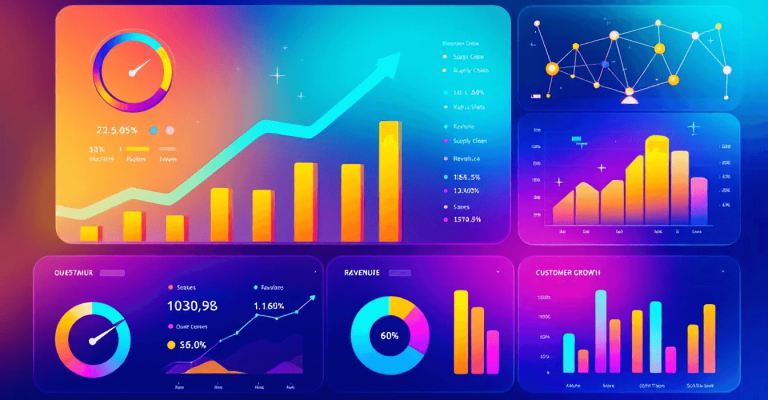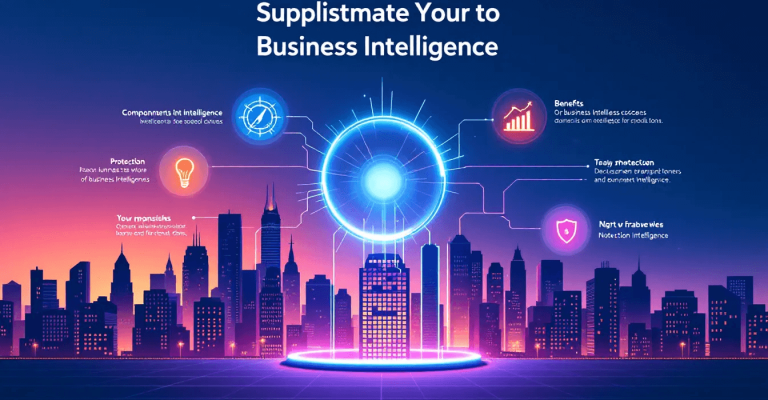What is Business Intelligence: The Essential Guide to Data-Driven Decision Making
- 11 November 2024
Table of contents
Business Intelligence (BI) is the process of converting raw data into meaningful insights for better business decisions. Data warehousing is a critical component of BI, providing a centralized repository for storing and managing large volumes of data. It involves collecting, analyzing, and visualizing data to understand patterns and trends, which helps organizations make informed decisions and optimize operations. So, what is business intelligence? This article will explore the core components, tools, benefits, and applications of BI.
Key Takeaways
- Business Intelligence (BI) combines technology and data to provide actionable insights that enhance decision-making and organizational performance.
Core components of BI include data collection and storage, data preparation, data governance, and data analysis, facilitating the transformation of raw data into meaningful insights.
Modern BI tools offer features such as real-time data analysis, data visualization, and self-service capabilities, empowering users to make informed decisions independently.
Understanding Business Intelligence

Business Intelligence is the art and science of using people and technology to collect, analyze, and transform data into actionable insights. It encompasses a set of strategies and technologies that help organizations make sense of their business information, ultimately driving better decision-making and performance through business intelligence bi.
Data integration plays a vital role in BI by combining data from different sources to provide a unified view for analysis.
The primary goal of BI is to analyze business data to support strategic decisions. BI helps organizations identify new opportunities and optimize their operations by uncovering patterns and trends. This approach enhances efficiency and provides a solid foundation for making informed, impactful decisions.
How Business Intelligence Works
Business intelligence (BI) is a technology-driven process that involves collecting, analyzing, and presenting data to support informed business decisions. The process of business intelligence typically involves several key steps:
The Core Components of Business Intelligence
At the heart of Business Intelligence lie three core components: data collection and storage, data preparation, and data analysis. Together, these components form a comprehensive framework that enables businesses to convert raw data into meaningful insights. Ensuring high data quality is crucial for accurate analysis and reliable insights.
Each component ensures data is accurately captured, efficiently processed, and effectively analyzed.
Data Collection and Storage
Business Intelligence relies on data from a variety of sources, including structured data from databases and unstructured data from social media and other external platforms. According to Merrill Lynch, over 85% of traditional business intelligence exists in unstructured forms, highlighting the importance of managing diverse types of data.
Storing data in a centralized location, like a data warehouse, improves accuracy and transparency. It also facilitates comprehensive analysis and querying, uncovering errors, and reducing compliance risks. Implementing robust data governance practices ensures data integrity, security, and compliance.
A centralized approach provides businesses with a single source of truth for their data, simplifying analysis and insight derivation.
Data Preparation
After data collection, it undergoes cleaning, transformation, and structuring to become suitable for analyzing data. Data cleansing is a critical step in this process, ensuring that data is accurate and free from errors.
Tools like Alteryx streamline this process, enhancing productivity for data analysts by providing staging areas for filtering and refining data.
Data Analysis
Data analysis is where the magic happens. BI tools employ various analytical methods, including descriptive, predictive, and prescriptive analytics, to uncover trends and make predictions. Data mining techniques search through vast datasets to identify patterns and relationships, often using automation to enhance efficiency. Effective data governance ensures that data is used responsibly and complies with regulatory requirements.
Data visualization plays a critical role in this process, enabling users to quickly grasp complex information through interactive dashboards, charts, and graphs. These visual tools not only make data more accessible but also enhance the ability to communicate insights effectively within the organization.
Key Features of Business Intelligence Tools

Modern business intelligence tools come packed with features designed to enhance the accessibility and usability of data. Key features include data visualization, real-time data analysis, and self-service BI capabilities. Data warehousing is a fundamental feature of many BI tools, providing a centralized repository for storing and managing data.
These tools are equipped with artificial intelligence and machine learning functionalities, allowing for deeper insights and more intuitive data interaction.
Data Visualization Tools
A centralized data warehouse enables consistent and efficient reporting by integrating data from multiple sources. Dashboards in BI software provide a graphical representation of data trends, which greatly enhances the decision-making process by making complex data more understandable and actionable. Data integration is essential for combining data from multiple sources, enabling comprehensive and accurate visualizations.
Many BI tools offer advanced data visualization features, such as geospatial analysis, which allows users to visualize data geographically. GoodData, for instance, specializes in providing real-time analytics through embedded dashboards tailored to user needs, offering a comprehensive view of business performance at a glance.
Real-Time Data Analysis
The ability to analyze data in real-time is a game-changer for businesses. Real-time BI enables organizations to respond immediately to changes in the business environment, providing up-to-date views of operations, customer behavior, and market trends. Effective data governance practices are crucial for ensuring the accuracy and reliability of real-time data.
Operational BI focuses on real-time data analysis and online analytical processing, which enhances the efficiency of daily business processes by providing timely insights. This capability allows organizations to continuously monitor operations and make quick adjustments, ultimately leading to better decision-making and improved performance.
Self-Service Business Intelligence
Self-service BI democratizes data access, allowing non-technical users to independently explore and analyze data. It fosters a data-driven decision-making culture, empowering employees at all levels to engage with data and derive insights. Data integration enables users to access and analyze data from multiple sources, enhancing the capabilities of self-service BI tools.
Leading self-service BI tools, such as Tableau and Qlik, enable users to perform analyses and create reports without relying heavily on IT departments. This not only streamlines the decision-making process but also reduces the workload on IT teams, allowing for more agile and responsive business operations.
Benefits of Implementing Business Intelligence

Business intelligence tools offer numerous benefits. Improved data quality and accuracy from BI lead to better business decisions and more efficient operations. BI tools facilitate timely access to relevant data, enabling quicker decision-making and more strategic planning. Data warehousing provides a centralized repository for data, enhancing data quality and accessibility.
BI integration with analytics empowers organizations to identify and effectively act on trends. This approach helps refine business processes, optimize resource allocation, and enhance productivity.
Specific industries, such as finance and healthcare, have seen significant improvements in revenue and operational efficiency through the use of BI.
Common Types of Business Intelligence Applications

Business intelligence applications come in various forms, each catering to specific needs. These include operational BI, mobile BI, and predictive analytics. Each type of application provides unique insights and capabilities, enhancing a company’s operational effectiveness and decision-making processes. Data integration is crucial for combining data from various sources, enabling different types of BI applications.
Operational BI
Operational BI focuses on enhancing efficiency and profitability by driving informed decision-making. It integrates data from various sources to provide a consolidated view of business operations, helping organizations optimize their processes and improve overall performance.
Implementing robust data governance practices ensures the proper management and security of operational data.
Mobile Business Intelligence
Mobile business intelligence makes BI applications accessible on smartphones and tablets, emphasizing ease of use and convenience. This capability allows users to access insights and make data-driven decisions regardless of their location, facilitating timely responses to changing business conditions. Data integration enables users to access and analyze data from multiple sources on mobile devices, enhancing the capabilities of mobile BI.
Predictive Analytics
Predictive analytics, a powerful branch of business analytics, focuses on forecasting future trends and behaviors. By utilizing historical data along with advanced algorithms and machine learning techniques, predictive analytics enables businesses to anticipate future outcomes and make proactive decisions. Ensuring high data quality is crucial for the accuracy and reliability of predictive models.
Popular Business Intelligence Vendors
The business intelligence market is populated by several major vendors offering a wide range of tools and solutions for business users. Many BI vendors offer data warehousing solutions, providing centralized repositories for storing and managing data.
Prominent vendors include:
- IBM
- Microsoft
- Oracle
- SAP
- SAS
- Salesforce
- Google (Looker)
- Alteryx
- Domo
- MicroStrategy
These vendors provide robust platforms that cater to various analytical needs, from data visualization to advanced analytics.
Self-service BI tools such as Tableau, Qlik, and Spotfire are popular for their user-friendly interfaces and powerful capabilities. Tableau, for instance, allows users to visualize data without requiring coding skills, making it accessible to a broader audience.
Domo offers flexibility in data storage, allowing businesses to store data either on its cloud or their own.
Industry Use Cases of Business Intelligence
Business intelligence is applied across various industries, each leveraging BI to enhance their operations and decision-making processes. From finance and healthcare to retail and manufacturing, BI provides valuable insights that drive strategic planning and operational efficiency.
Data integration is crucial for combining data from various sources, enabling comprehensive insights in different industries.
Finance
In the finance sector, BI tools offer a holistic view of financial health, enabling institutions to analyze historical data, calculate risks, and predict trends. A notable example is a financial institution in the UK that enhanced its efficiency by integrating BI for report development, benefiting teams across customer service, online banking, and branch staffing. Ensuring high data quality is crucial for the accuracy and reliability of financial analyses.
Healthcare
Healthcare organizations leverage BI tools to improve patient care and streamline operations. By analyzing patient data, healthcare providers can enhance treatment effectiveness and manage resources more efficiently. Furthermore, the integration of BI tools has empowered less technical employees to engage with data-driven insights, fostering a more informed and efficient workforce. Implementing robust data governance practices ensures the proper management and security of patient data.
Retail
Retailers use BI to gain insights into buying behaviors, preferences, and trends among their customers. This information helps tailor marketing efforts and product offerings to better meet customer needs. Data integration enables retailers to combine data from multiple sources, providing comprehensive insights into customer behavior and trends.
By analyzing historical and current data sales data, retailers can:
- Predict demand
- Manage inventory levels more effectively
- Reduce stockouts and excess inventory
- Enhance customer satisfaction
- Improve operational efficiency
Emerging Trends in Business Intelligence

The landscape of Business Intelligence is continually evolving, with several emerging trends shaping its future. Artificial Intelligence (AI) integration in BI tools automates data analysis and enhances the generation of insights, managing complex datasets beyond human capabilities. Qlik, for instance, employs AI to enhance data management and uncover insights within large datasets. Data warehousing is evolving with new technologies and practices, enhancing its capabilities and efficiency.
Other significant trends include Natural Language Processing (NLP), enabling users to interact with data analytics tools using conversational language, and data storytelling, which combines visualization with narrative techniques for context and insights.
Cloud-based BI solutions are also gaining traction, offering scalable and flexible access to data and analytical tools.
Business Intelligence vs. Business Analytics
While often used interchangeably, Business Intelligence and Business Analytics serve different purposes. Business Intelligence primarily focuses on descriptive analytics, summarizing historical performance through metrics like mean and standard deviation. It emphasizes understanding and interpreting past data to inform current business operations and decisions. Ensuring high data quality is crucial for both BI and BA, as it impacts the accuracy and reliability of analyses and insights.
Business Analytics aims to predict and optimize future outcomes. Predictive analytics, a key component, uses historical data to forecast future trends and potential outcomes. Business Analytics not only summarizes past data but also prescribes future actions, enhancing processes and driving proactive decision-making.
Summary
Business Intelligence is a powerful tool that transforms raw data into actionable insights, driving strategic decision-making and operational efficiency. By leveraging BI tools, organizations can uncover patterns, predict future trends, and make informed decisions that propel their business forward. Whether through data visualization, real-time analysis, or self-service BI, the benefits of BI are profound and far-reaching. Embrace the power of Business Intelligence to stay ahead in today’s data-driven world. Effective data governance is essential for the overall success of BI initiatives, ensuring data integrity, security, and compliance.
Frequently Asked Questions
What is Business Intelligence?
Business Intelligence (BI) is essential for transforming data into actionable insights that facilitate strategic decision-making within an organization. It leverages technologies and human expertise to analyze data effectively.
Data warehousing is a fundamental aspect of BI, providing a centralized repository for storing and managing data.
How does BI improve decision-making?
BI enhances decision-making by delivering precise and timely access to pertinent data, which allows organizations to recognize trends, optimize operations, and make well-informed choices based on visualized information.
Ensuring high data quality is crucial for the accuracy and reliability of insights, ultimately improving decision-making.
What are the core components of BI?
The core components of Business Intelligence (BI) are data collection and storage, data preparation, and data analysis. Together, these components facilitate the transformation of raw data into actionable insights. Implementing robust data governance practices ensures the proper management and security of data, enhancing the effectiveness of BI.
What are some common BI tools and vendors?
Common BI tools and vendors include IBM, Microsoft, Oracle, SAP, and analytics platforms such as Tableau and Qlik for self-service capabilities. These tools are essential for effective data analysis and reporting.
Many BI vendors offer data warehousing solutions, providing centralized repositories for storing and managing data.
How is BI used in different industries?
Business Intelligence (BI) is utilized across multiple sectors such as finance, healthcare, and retail to facilitate informed decision-making, enhance operational efficiency, and support strategic planning. This multifaceted application demonstrates the critical role BI plays in optimizing performance and competitiveness in diverse industries. Data integration is crucial for combining data from various sources, enabling comprehensive insights in different industries.
Fun Fact!
Using Container Depot Management Software is like giving your shipping yard a brain! It tracks containers, optimizes space, and prevents costly errors, just like Tetris—but for real-world logistics! Without it, depots could quickly turn into a chaotic puzzle that’s impossible to solve!